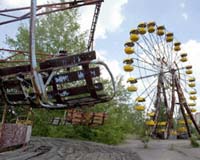 |
Chernobyl, Ukraine (AFP) April 18, 2011 Fallout from Chernobyl remains a poorly-investigated hazard for the environment a quarter of a century after the disaster, say experts. According to anecdotal evidence, animals such as beavers, deer, wild horses, hawks and eagles have returned in abundance to Chernobyl's 30-kilometre (18-mile) exclusion zone since humans fled and hunting was outlawed. But this picture is misleading, said University of South Carolina biology professor Tim Mousseau, one of the few scientists to have probed biodiversity around Chernobyl in depth. "Chernobyl is definitely not a haven for wildlife," he said in a phone interview. "When you actually do the hard work, of conducting a scientific study, where you rigorously control for all the variables, and you do this repeatedly in many different places, the signal is very strong. "There are many fewer animals and many fewer kinds of animals than you would expect." In 2010, Mousseau and colleagues published the biggest-ever census of wildlife in the exclusion zone. It showed that mammals had declined and insect diversity, including bumblebees, grasshoppers, butterflies and dragonflies, had also fallen. And in a study published in February this year, they netted 550 birds, belonging to 48 species at eight different sites, and measured their heads to determine the volume of their brains. Birds living in "hot spots" had five percent smaller brains than those living where radiation was lower -- and the difference was especially great among birds less than a year old. Smaller brains are linked to a lower cognitive ability and thus survival. The study suggested many bird embryos probably do not survive at all. "This clearly ties to the level of background contamination," said Mousseau. "There are bound to be consequences for the ecosystem as a whole." Mousseau said it was vital to explore the link, not least because of the relevance for Fukushima, which with Chernobyl is the only nuclear accident to rate a maximum seven on a world ranking of gravity. But funding for Western research into environmental impacts at Chernobyl has slumped and many Russian-language studies are never translated into English, he said. Radioactive dust and ash spewed over more than 200,000 square kilometres (77,000 square miles) after Chernobyl's No. 4 reactor exploded and caught fire on April 26 1986. Ukraine, Belarus and Russia were most affected, although deposits reached as far north as Scotland and as far west as Ireland, requiring in some places long-term restrictions on cattle grazing. Contamination, even in the notorious exclusion zone, is not uniform. Some areas are quite clean. But a few hundred metres (yards) away, there can be "hotspots" -- determined by the winds and rain that deposited the particles, or the leaves that trapped them -- where radiation is far higher. Today, the main threats are caesium 137 and to a lesser degree strontium 90, which decay slowly in a timescale measured in decades, according to France's Institute for Radiological Protection and Nuclear Safety (IRSN). Their radioactivity has fallen by orders of magnitude from 25 years ago but in the hotspots it lingers in a 10- to 20-centimetre (four- to eight-inch) layer of topsoil. They thus provide a low-dose but constant and lasting source of exposure. Radioactive particles pass from the soil into plants via their roots, into animals that eat the vegetation and into the humans that eat their meat or drink their milk. Absorbed into the bones and organs, caesium emits alpha radiation, which damages DNA in close proximity, boosting the risk of mutant cells that become tumours -- or, in reproductive cells, are handed on in progeny. Western and southern Ukraine were not affected by fallout from Chernobyl, and in the country's large farms and food factories there is no risk because of surveillance, say scientists. But radioactivity still affects rural areas of northern Ukraine, where poor farmers pick wild mushrooms and berries and cannot afford to buy clean hay from uncontaminated regions for their cows. Valery Kashparov, director of the Ukrainian Institute of Agricultural Radiology, said the government cut off funds for radiation monitoring in 2008. Around 400,000 euros (600,000 dollars) are needed annually to ensure this food is uncontaminated. "The contamination is going down, but it will take dozens of years for nature to bring it down to safe levels," he said. In research presented in Kiev this month, scientists for Greenpeace purchased food from village markets in two administrative regions, Zhytomyr and Rivne. Tests found caesium 137 above permissible levels in many samples of milk, dried mushrooms and berries, they said. Levels were extremely high in Rivne, where a peaty, waterlogged soil transmits radioactive particles more easily to plants than other soil types.
Share This Article With Planet Earth
Related Links Bringing Order To A World Of Disasters A world of storm and tempest When the Earth Quakes
 Trauma and controversy: Chernobyl's health legacy
Trauma and controversy: Chernobyl's health legacyKiev (AFP) April 18, 2011 Every year, Volodymyr Palkin spends at least two months in a Kiev hospital. He was one of hundreds of thousands of rescue workers sent to fight the disaster at the Chernobyl nuclear plant and says his health has been permanently ruined by his work. Yet 25 years after the world's worst nuclear disaster on April 26, 1986, huge controversy remains over the true extent of the damage caused to he ... read more |
|
| The content herein, unless otherwise known to be public domain, are Copyright 1995-2010 - SpaceDaily. AFP and UPI Wire Stories are copyright Agence France-Presse and United Press International. ESA Portal Reports are copyright European Space Agency. All NASA sourced material is public domain. Additional copyrights may apply in whole or part to other bona fide parties. Advertising does not imply endorsement,agreement or approval of any opinions, statements or information provided by SpaceDaily on any Web page published or hosted by SpaceDaily. Privacy Statement |